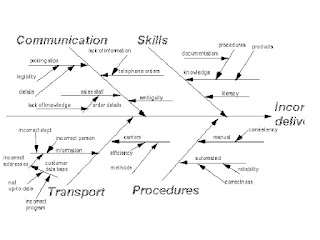Cause & Effect Diagram
The cause and effect diagram was first used by Kaoru Ishikawa in 1943 to explain to a group of engineers working in Kawasaki steel works about working process and how various work factors could be stored and related. For this reason these diagrams are called as Ishikawa diagrams, and also called by many names like fish-bone diagrams because they look like a fish skeleton. These are also called as Cause and Effect diagrams because they help us to think of all the possible causes of the problem instead of just considering the most obvious ones. These diagrams are one of the types used in quality management techniques. When utilizing a team approach to problem solving, there are often many opinions as to the problem's root cause. One way to capture these different ideas and stimulate the team's brainstorming on root causes is the cause and effect diagram, commonly called a fishbone.
This diagram provides a structured way to help you think through all possible causes of a problem. This helps us top carry out a thorough analysis of a situation.
Steps to be followed to solve a problem using Cause and Effect diagram are:
- Identify the problem
- Work out the major factors involved
- Identify possible causes
- Analyze your diagram
To construct a fishbone, start with stating the problem in the form of a question, such as 'Why is the help desk's abandon rate so high?' Framing it as a 'why' question will help in brainstorming, as each root cause idea should answer the question. The team should agree on the statement of the problem and then place this question in a box at the 'head' of the fishbone.
The rest of the fishbone then consists of one line drawn across the page, attached to the problem statement, and several lines, or 'bones,' coming out vertically from the main line. These branches are labeled with different categories. The categories you use are up to you to decide.
You should feel free to modify the categories for your project and subject matter.
Once you have the branches labeled, begin brainstorming possible causes and attach them to the appropriate branches. For each cause identified, continue to ask 'why does that happen?' and attach that information as another bone of the category branch. This will help get you to the true drivers of a problem.
Once you have the fishbone completed, you are well on your way to understanding the root causes of your problem. It would be advisable to have your team prioritize in some manner the key causes identified on the fishbone.
Cause Enumeration
In general, it is difficult to identify which are the main causes. In such situations there are ways of identifying them effectively.
- Brain storm and get a list of causes.
- Sort the list by grouping
- Identify each group by giving a name and make your cause and effect diagram.
The advantage of the cause enumeration technique is that you stand a much better chance that all causes will be listed, especially hidden ones, and your diagram will be a complete and useful picture. The disadvantage is that it may be difficult to relate all the causes clearly to the result, making the diagram hard to draw.



No comments:
Post a Comment